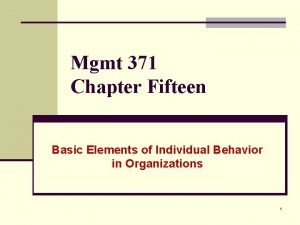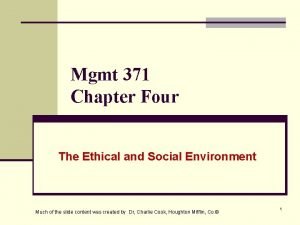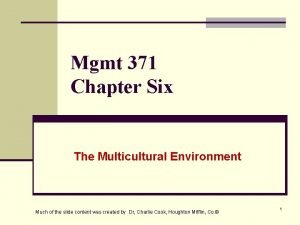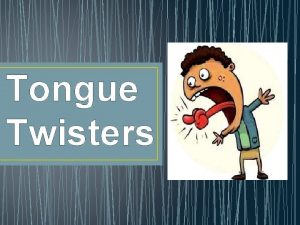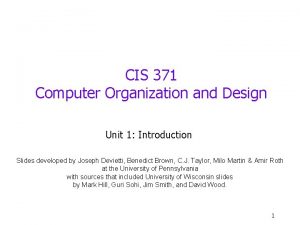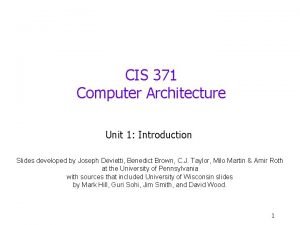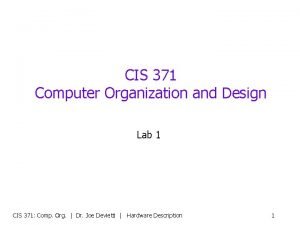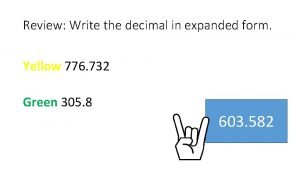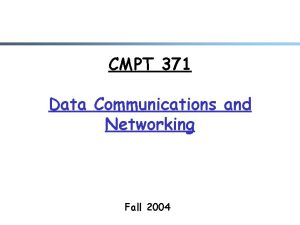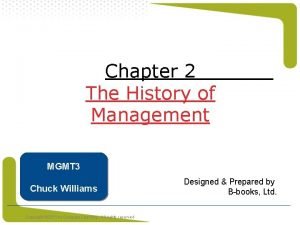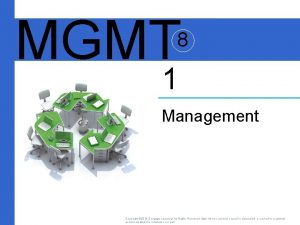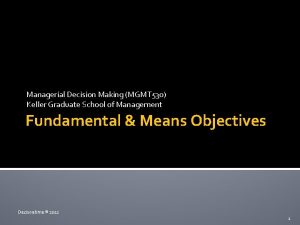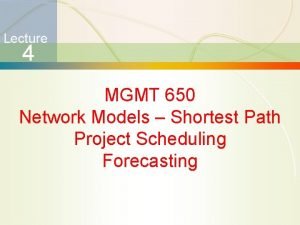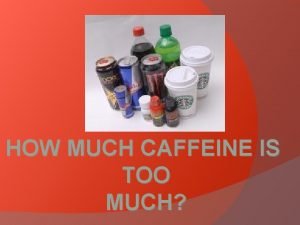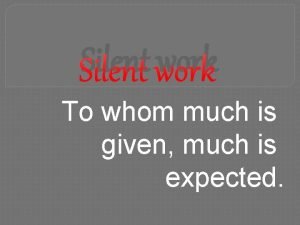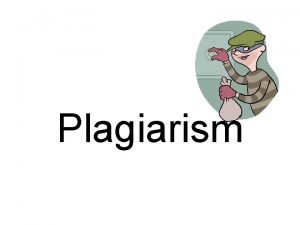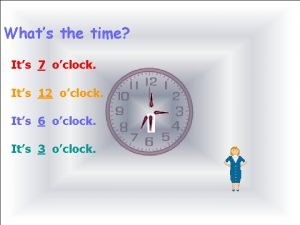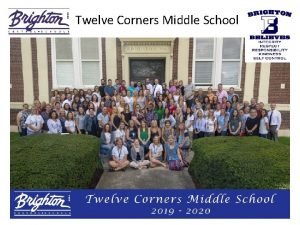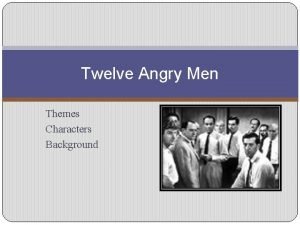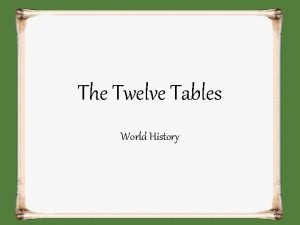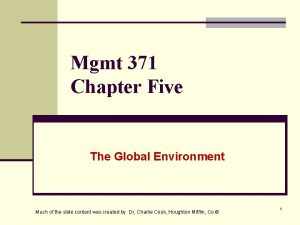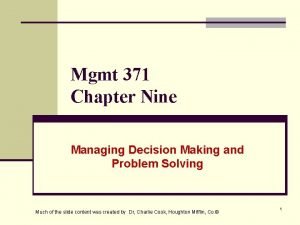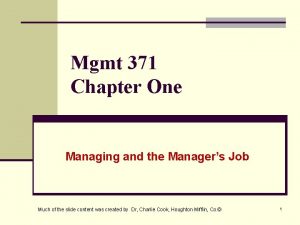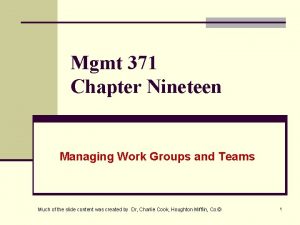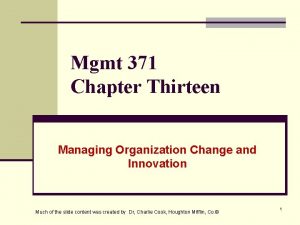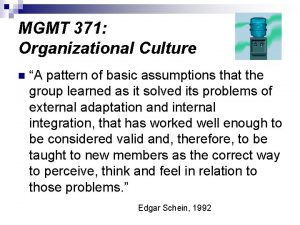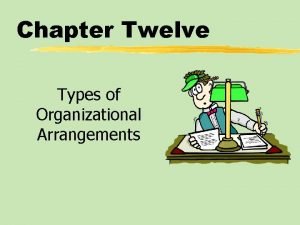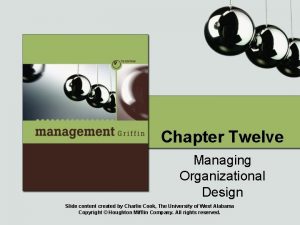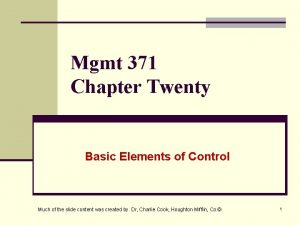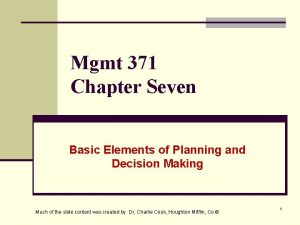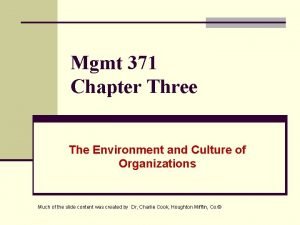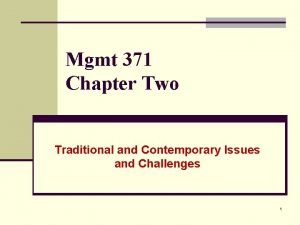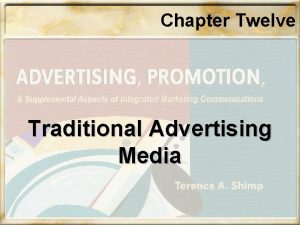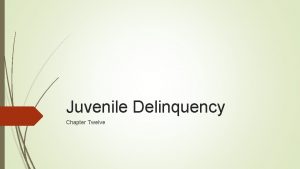Mgmt 371 Chapter Twelve Managing Organizational Design Much































- Slides: 31

Mgmt 371 Chapter Twelve Managing Organizational Design Much of the slide content was created by Dr, Charlie Cook, Houghton Mifflin, Co. © 1

The Nature of Organization Design n The overall set of structural elements and the relationships among those elements used to manage the total organization. n A means to implement strategies and plans to achieve organizational goals. n Organization Design Concepts n Organizations are not designed and then left intact. n Organizations are in a continuous state of change. n Designs for larger organizations are extremely complex and have many nuances and variations. 2

Universal Perspectives on Organization Design n Bureaucratic Model (Max Weber) n A logical, rational, and efficient organization design based on a legitimate and formal system of authority. n Modeled on Helmuth von Moltke's development of the General Staff. 3

Universal Perspectives on Organization Design n Bureaucratic Model (Max Weber) n Characteristics n A division of labor with each position filled by an expert. n A consistent set of rules that ensure uniformity in task performance. n A hierarchy of positions which creates a chain of command. n Impersonal management; with the appropriate social distance between superiors and subordinates. n Employment and advancement is based on technical expertise, and employees are protected from arbitrary dismissal. 4

Bureaucratic Model n Advantages Efficiency in function due to well-defined practices and procedures. n Organizational rules prevent favoritism. n Recognition of and requirement for expertise stresses the value of an organization’s employees. n 5

Bureaucratic Model n Disadvantages n Organizational inflexibility and rigidity due to rules and procedures. n Neglects the social and human processes within the organization. n Belief in “one best way” to design an organization does not apply to all organizations and their environments. 6

Rensis Likert: System 1 and System 4 Organizations 7

Situational Influences on Organization Design n Core Technology n Is the conversion processes used to transform inputs into outputs. n Is an organization’s most important technology. n Joan Woodward n Initially sought a correlation between organization size and design; instead, she found a potential relationship between technology and design: n As the complexity of technology increases, so do the number of levels of management. 8

Situational Influences on Organization Design (Woodward) n Woodward’s Basic Forms of Technology n Unit or small-batch technology n Produces custom-made products to customer specifications, or else produces in small quantities, similar to Likert’s System 4 organization and organic organizations. n Large batch/mass production n Uses assembly-line production methods to manufacture large quantities of products; resembles Likert’s System 1 and mechanistic organizations. n Continuous process n Uses continuous-flow processes to convert raw materials by process or machine into finished products; resembles Likert’s System 4 and organic organizations. 9

Situational Influences on Organization Design (Burns & Stalker) n Burns and Stalker n Forms of the organizational environment n Stable environments that remain constant over time. n Unstable environments subject to uncertainty and rapid change. n Organization Designs n Mechanistic organizations that are similar to bureaucratic or System 1 models and ; found most frequently in stable environments. n Organic organizations that are flexible and informal models; usually found in unstable and unpredictable environments. 10

Situational Influences on Organization Design (Lawrence & Lorsch) n Lawrence and Lorsch n Differentiation n n The extent to which the organization is broken down into subunits. Integration n The degree to which the various subunits must work together in a coordinated fashion. 11

Situational Influences on Organization Design (cont’d) n Organizational Size n Defined as the total number of full-time or full-time equivalent employees n Research findings: n Small firms tend to focus on their core technology. n Large firms have more job specialization, standard operating procedures, more rules and regulations, and are more decentralized. n Organizational Life Cycle n A progression through which organizations evolve as they grow and mature—birth, youth, midlife, maturity and decline. 12

The Organizational Life Cycle Birth Youth Maturity Decline 13

Strategy and Organization Design n Structure follows strategy. n Corporate-Level Strategy n Single-product strategy n Related or unrelated diversification n Portfolio approach to managing strategic business units 14

Strategy and Organization Design (cont’d) n Business-Level Strategy n Defender n Prospecting n Analyzer n Generic Competitive Strategies n Differentiation n Cost leadership n Focus 15

Strategy and Organization Design (cont’d) n Organizational Functions n Major functions of the organization influence an organization’s design. 16

Basic Forms of Organization Design (Functional Design) n Functional or U-form (Unitary) Design n Organizational members and units are grouped into functional departments such as marketing and production. n Coordination is required across all departments. n Design approach resembles functional departmentalization in its advantages and disadvantages. 17

Functional Design for a Small Manufacturing Company 18

Basic Forms of Organization Design (Holding Design) n Conglomerate or H-form (Holding) Design n n Organization consists of a set of unrelated businesses with a general manager for each business. Holding-company design is similar to product departmentalization. Coordination is based on the allocation of resources across companies in the portfolio. Design has produced only average to weak financial performance; has been abandoned for other approaches. 19

Conglomerate (H-form) Design at Samsung 20

Basic Forms of Organization Design (Divisional Design) n Divisional or M-form (Multidivisional) Design n Multiple businesses in related areas operating within a larger organizational framework. n Results from a strategy of related diversification. n Some activities are decentralized down to the divisional level; others are centralized at the corporate level. n M-form design advantages are the opportunities for coordination and sharing of resources. n Successful M-form organizations can out perform U -form and H-form organizations. 21

Multidivisional (M-form) Design at Limited Brands 22

Basic Forms of Organization Design (Matrix Design) n Matrix Design n Two overlapping bases of departmentalization: n A set of product groups or temporary departments are superimposed across the functional departments. n Employees in the matrix belong to their departments and the project team: n A multiple command structure in which an employee reports to both departmental and project managers. n A matrix design is useful when: n There is strong environmental pressure. n There are large amounts of information to be processed. n There is pressure for shared resources. 23

Basic Forms of Organization Design (Matrix Design) n Matrix Design Advantages n Enhances organizational flexibility. n Creates high motivation and increased organizational commitment for team members. n Gives team members opportunity to learn new skills. n Provides an efficient way for the organization to use its human resources. n Uses team members as bridges to their departments for the team. n Useful as a vehicle for decentralization. 24

Basic Forms of Organization Design (Matrix Design) n Matrix Design Disadvantages n Employees are uncertain about reporting relationships. n Managers may view design as an anarchy in which they have unlimited freedom. n The dynamics of group behavior may lead to slower decision making, one-person domination, compromise decisions, or a loss of focus. n More time may be required for coordinating taskrelated activities. 25

A Matrix Organization 26

Basic Forms of Organization Design (Hybrid Designs) n Hybrid Designs n Based on two or more common forms of organization design—may have a mixture of related divisions and a single unrelated division. n Most organizations use a modified form of organization design that permits them to have sufficient flexibility to make adjustments for strategic purposes. 27

Emerging Issues in Organization Design n The Team Organization n Relies almost exclusively on project-type teams, with little or no underlying functional hierarchy. n The Virtual Organization n n Has little or no format structure with few permanent employees, leased facilities, and outsourced basic support services. May conduct its business entirely on-line and exists only to meet for a specific and present need. 28

Emerging Issues in Organization Design n The Learning Organization (Peter Senge) n n Works to facilitate the lifelong learning and development of its employees while transforming itself to respond to changing demands and needs. According to Peter Senge, the basic rationale for such organizations is that in situations of rapid change only those that are flexible, adaptive and productive will excel. 29

Issues in International Organization Design n The trend toward internationalization of business n How to design a firm to deal most effectively with international forces and to compete in global markets: n Create an international division? n Establish an international operating group? n Make international operations an autonomous subunit? 30

Common Organization Designs for International Organizations 31
 Mgmt 371
Mgmt 371 Mgmt 371
Mgmt 371 Mgmt 371 final exam
Mgmt 371 final exam English tongue twisters funny
English tongue twisters funny Cis 371
Cis 371 Cis 371
Cis 371 370 en yakın yüzlüğe yuvarlama
370 en yakın yüzlüğe yuvarlama Cis371
Cis371 284 371 in word form
284 371 in word form Cmpt 371
Cmpt 371 6 371
6 371 Top dop
Top dop Infrastructure mgmt
Infrastructure mgmt Tim washington ppm
Tim washington ppm Mgmt 11 principles of management
Mgmt 11 principles of management Mgmt 4
Mgmt 4 Mgmt+8
Mgmt+8 Keller graduate school of mgmt
Keller graduate school of mgmt Mgmt 341
Mgmt 341 Mgmt 650 quiz 4
Mgmt 650 quiz 4 Mgmt 650
Mgmt 650 Mgmt ama
Mgmt ama Mgmt ama
Mgmt ama Mgmt 310 purdue
Mgmt 310 purdue Decaffeinated hot chocolate
Decaffeinated hot chocolate To whom much is given much is required meaning
To whom much is given much is required meaning How much is too much plagiarism
How much is too much plagiarism Its 12 o clock
Its 12 o clock What are the terrible twelve water pollution
What are the terrible twelve water pollution Tcms brighton
Tcms brighton 12 angry men themes
12 angry men themes Si in ius vocat ito
Si in ius vocat ito
